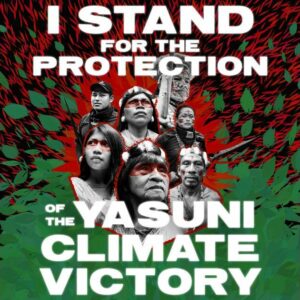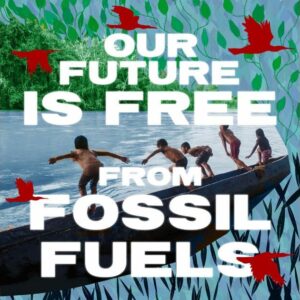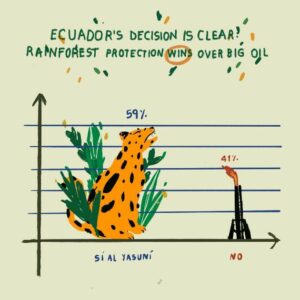
At least 15 coronavirus cases confirmed among the Siekopai nation, exacerbating risk of cultural and physical extinction
For more information, contact: Sophie Pinchetti at +593 98 148 4873
sophie@amazonfrontlines.org
5th May 2020. Lago Agrio, Sucumbios, Ecuador – At least 15 cases of COVID-19 have now been confirmed among the Siekopai people of Ecuador, often referred to as Secoya, a small Upper Amazonian indigenous nation of less than a thousand people whose rainforest homeland stretches across 25 000 hectares. The cases mark an alarming increase in contagion among Ecuador’s highly vulnerable indigenous communities, and stokes fears of ethnocide for over 500,000 indigenous peoples belonging to 11 nations, who have confirmed at least 24 COVID-19 cases to date.
Yesterday, Siekopai leaders organized a virtual press conference from the Siekopai community of San Pablo to inform the global community about the grave existential threat which COVID-19 poses to their people, who, like other ethnic minorities such as the Kofan, Siona, Waorani and Sapara, are already at risk of cultural and physical extinction.
Community members sounded the alarm on April 14t h following the death of one of their elders in the community of Bella Vista who suffered from COVID-19 symptoms including fever and coughing. Despite seeking medical attention and making urgent appeals to the government after this first suspected COVID-19 death, the Siekopai were not offered testing. On April 15th, one of the elder’s family members was tested with a PCR test and fourteen days later the community was informed that the result was positive for COVID-19. On April 21s t, another elder in the community of Waiya passed away after experiencing COVID-19 symptoms.
After receiving help from allies and human rights organizations to locate and deliver rapid tests, the Siekopai were able to organize testing in three communities with health workers from the Ministry of Health in the region of Sucumbios between the 27t h and 29t h April. The results tested positive for coronavirus for 14 members of the indigenous nation.
The government’s Health Ministry has pledged to provide a contingency plan for the nation in the face of this crisis, but Siekopai leaders have denounced what they feel is an inadequate response: “We can’t be excluded from medical attention. In the 19th century, we were already victims of this type of disease. Today, we do not want to see history repeat itself. It would be tragic for the Ecuadorian State to allow the same disaster to repeat itself in the 21st century”, explains Justino Piaguaje, President of Ecuador’s Siekopai nation. On Monday, the Inter-American Commission on Human Rights called on the Ecuadorian State to urgently “adopt efficient measures to protect the right to health and the integrity of the Siekopai people, as well as other peoples facing similar risks during this pandemic”.
Residing along the lowland rivers of eastern Ecuador and northern Peru, the Siekopai’s recent history has been an all too common one of a forest people who barely survived the diseases of colonial contact in the 17th century, and who have lived on a frontier of constant resource extraction that has ranged from the exploitation of rubber and other tree gums in the early 1900’s to tree-based perfumes and essential oils; jaguar and otter pelts; precious tropical hardwoods; petroleum and gold extraction; and most recently, landscape-level transformation into African oil palm and other mono-crops.
Ecuador’s Siekopai people, along with the Kofan and Siona nations and campesino communities, have been instrumental in leading the historic and ongoing lawsuit against oil giant Chevron-Texaco for the environmental and human damages caused by the company’s deliberate dumping of toxic waste into nearby rivers and streams. Over the past two decades, their resistance efforts have helped to spearhead demands for clean-up of the contamination on their rainforest homelands, the consequence of decades of irresponsible oil exploitation in one of the most biodiverse places on earth.
In the wake of a tragic legacy of foreign pandemics decimating entire indigenous communities and even cultures, indigenous peoples— who have been protecting the Amazon for thousands of years— are one of our planet’s most vulnerable populations. Especially at risk are indigenous elders, the guardians of thousands of years of ancestral knowledge about the Amazon rainforest and how to protect it. The COVID-19 pandemic compounds the threats indigenous peoples face to their cultural and physical survival, exacerbating existing inequalities and systematic rights violations, such as invasions from illegal loggers, poachers and miners and the destructive impacts of fossil fuel extraction and big agriculture.
Several Siekopai families decided to take more drastic measures to escape the virus, and in mid-April they traveled some one hundred miles deeper into the forest to their ancestral heartland of Lagarto Cocha on the border between Ecuador and Peru. “Lagarto Cocha in the past served as a place for our ancestors to protect themselves from invaders and diseases. Today, in the face of similar conditions, it offers us the same safe haven”, explains Justino Piaguaje.
Along with other indigenous nations of Ecuador, the Siekopai are warning of an impending public health calamity in their communities as Ecuador faces among the most aggressive outbreaks in Latin America and one of the highest death tolls in the world. They are demanding an immediate moratorium on any activity that includes the entering of foreign persons into indigenous territories, the development of mining activities, logging, oil exploration and extraction, industrial agriculture, religious proselytization, or increased militarization, especially in transborder territories under pressure from armed actors and organized crime. In April, indigenous communities and organizations in Ecuador also launched an “Amazon Emergency Action Fund (COVID-19)” in order to raise urgent support internationally to help prevent the spread of the coronavirus into indigenous territories, and to guarantee Indigenous peoples’ survival.
The total number of confirmed coronavirus infections among the country’s Amazonian indigenous nations stands at 24, scattered across the two Amazonian regions of Pastaza and Sucumbios. In late April, the Achuar people also confirmed 2 cases, and the Kichwa people of Santa Clara tested positive for 7 cases. However, it is still difficult to determine with certainty the extent of the advance of the pandemic due to a lack of sufficient testing.




